![]()
The Pre-Raphaelite Ophelia
| These Pre-Raphaelite images were part of a new and intricate traffic between images of woman and madness in the late nineteenth-century literature, psychiatry, drama, and art. First of all, superintendents of Victorian lunatic asylums were also enthusiasts of Shakespeare, who turned to his dramas for models of mental aberration that could be applied to their clinical practice. The case study of Ophelia was one that seemed particularly useful as an account of hysteria or mental breakdown in adolescence, a period of sexual instability which the Victorians regarded as risky for women's mental health. - Elaine Showalter,"Representing Ophelia: Women, Madness, and the Responsibilities of Feminist Criticism" in Susanne L.Wofford (ed.), Hamlet, Bedford Books, Boston, 1994. p. 229f. |
Probably the most important of the mid-nineteenth century paintings of Ophelia was John Everett Millais' painting of 1851-2. As we shall see, the pose of his drowning Ophelia set the standard for many of the representations that were to follow.
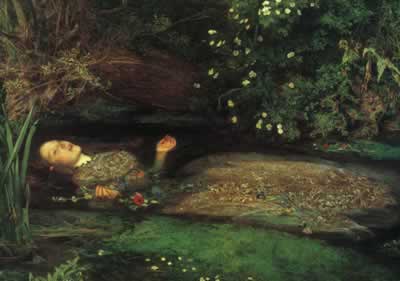
John
Everett Millais, Ophelia, 1852
An interesting story about the creation of this painting accompanied its first showing at the Royal Academy Exhibition in 1852, and added to the publicity it attracted.
| Millais began work on the painting in the summer of 1851, painting the river and the background by the River Ewell near Kingston-Upon-Thames. The outdoor location caused him trouble. 'I sit tailor-fashion', he wrote, 'under an umbrella throwing a shadow scarcely larger than a halfpenny for eleven hours, with a child's mug within reach to satisfy my thirst from the running stream beside me ... am also in danger of being blown by the wind into the water, and becoming intimate with the feelings of Ophelia when the lady sank to muddy death. His model for Ophelia, Elizabeth Siddal also suffered fleshly mortifications when she sat for the picture. The painting was completed in London during the following winter and Miss Siddal had to lie in a bath of water, heated by oil lamps from below. The cold she caught as a result brought a complaint against the artist from Miss Siddal's father, with the threat for an action of £50 damages. The action was settled and Miss Siddal's portrait considered to be the best likeness ever painted of her. - Andrea Rose, The Pre-Raphaelites, Phaidon, London, 1977, p.54. |
Notice the similarity of position chosen for the drowned Ophelia in the bronze relief created by Antoine Auguste Préault.
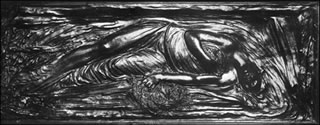
Antoine Auguste Préault, Ophélie, 1876
A similar improbable position appears in Gordon Browne's illustration for the Henry Irving edition of the Works of William Shakespeare in 1890.
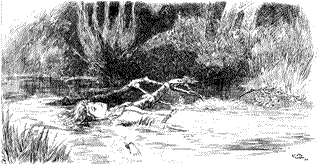
Laurence Olivier also seems to have had the Millais image in mind for his 1948 film production. Once again, we find Ophelia on her back, facing upward as if resting in her watery repose.
Even though the subject of Paul Delaroche's 1855 painting The Young Martyr was not Ophelia, echoes of Millais are still apparent in the image and its composition.
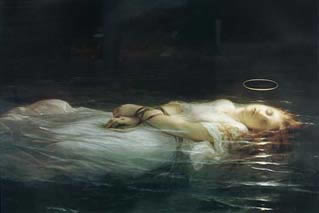
Arthur Hughes' Ophelia appeared at the same time as Millais' but with far less fanfare.
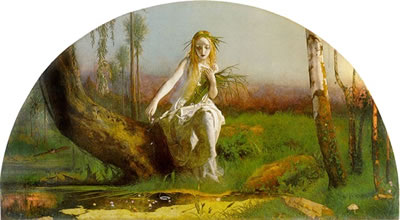
Arthur Hughes, Ophelia, 1852
Perhaps because of the common subject matter, Millais himself was attracted to the painting.
| His work was most closely influenced by Millais, although curiously (having known Hunt, Rossetti and Brown for some time) he did not meet Millais until 1852, when they both had paintings entitled Ophelia in the Royal Academy exhibition. Hughes' work was poorly placed, hung in the octagon room, commonly known by attests as 'the condemned cell.' Millais, however, spotted the picture and admired it. Hughes met him in front of the picture and later recalled that Millais 'had just been up a ladder looking at my picture, and that it gave him more pleasure than any picture there, but adding very truly that I had not painted the right kind of stream.' In fact the stream and strewn flowers are the most convincingly Pre-Raphaelite portions of the work - tightly painted and clear. The rest is moody, its misty greens and dusty reds suggestive, rather than illustrative, of the sadness of Ophelia. – Andrea Rose, The Pre-Raphaelites, Phaidon, London, 1977. p.58. |